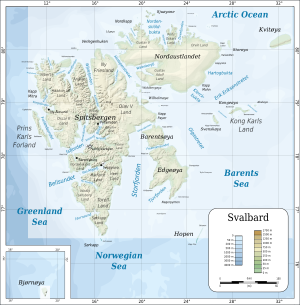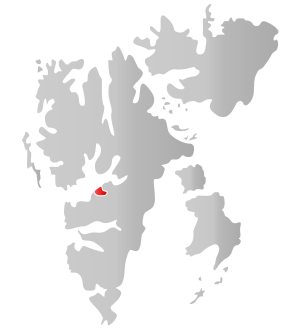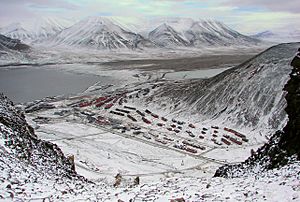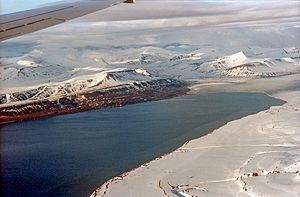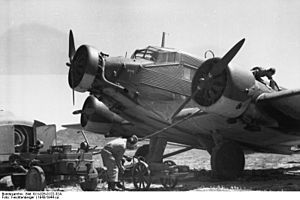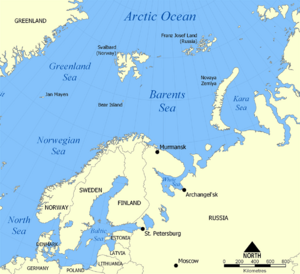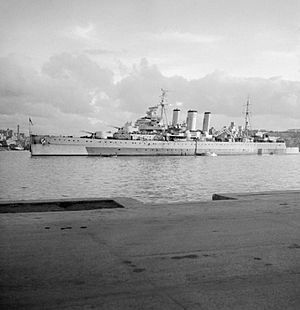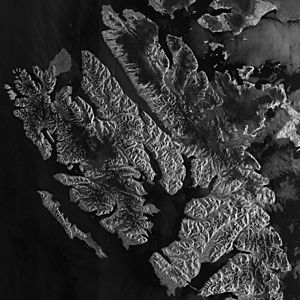Operation Gearbox II facts for kids
Quick facts for kids Operation Gearbox II |
|||||||
|---|---|---|---|---|---|---|---|
| Part of the Arctic Campaign of the Second World War | |||||||
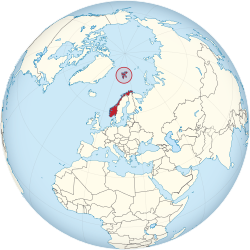 Global view of Norway (Svalbard circled) |
|||||||
|
|||||||
| Belligerents | |||||||
| Commanders and leaders | |||||||
| Albert Tornerud | |||||||
| Casualties and losses | |||||||
| 31 prisoners of war | |||||||
Operation Gearbox II was a special mission during World War II. It took place from September 1942 to September 1943. This operation involved soldiers from Norway and Britain. Their goal was to protect the Arctic island of Spitsbergen in the Svalbard islands.
Earlier, an attempt to set up a base, called Operation Fritham, failed. Two ships carrying the soldiers were sunk by German planes in May 1942.
Then came Operation Gearbox (June–September 1942). Fifty-seven Norwegian soldiers arrived with supplies. They made the defenses stronger at Barentsburg. They also got ready for Gearbox II. This new mission would bring more Norwegian soldiers. It was also part of the plan for Convoy PQ 18. The aim was to stop a disaster like Convoy PQ 17. In that convoy, 24 out of 35 supply ships were sunk.
A group of supply ships, called Force P, sailed from Scapa Flow in Scotland. They reached Lowe Sound in Svalbard a few days later. From September 9 to 13, destroyers from Convoy PQ 18 refueled there. This happened before the convoy entered the area where German planes could attack.
In June 1943, Norwegian soldiers chased away a German weather team from the island. Later, on September 7, a German fleet attacked Spitsbergen. This was called Operation Zitronella. The fleet included the huge battleship Tirpitz. They captured 31 prisoners. They also destroyed much of the base and equipment from Operation Gearbox II. On October 19, the American cruiser USS Tuscaloosa brought more Norwegian troops.
Why Svalbard Was Important
Svalbard's Location
The Svalbard islands are in the Arctic Ocean. They are about 650 miles (1,046 km) from the North Pole. The islands have mountains with snow all year. Some parts have glaciers. In winter, everything is covered in snow. The bays freeze over.
Spitsbergen Island has many large fjords (narrow inlets of the sea) on its west coast. Isfjorden is very wide. The Gulf Stream makes the water warmer. So, the sea is free of ice in summer.
People lived in settlements like Longyearbyen and Barentsburg. These were in inlets along Isfjorden. The Svalbard Treaty of 1920 made the islands neutral. This meant no country owned them. It also allowed different countries to mine and fish there. Before 1939, about 3,000 people lived there. Most were Norwegian and Russian miners. They mined coal. Ships would collect the coal after the summer ice melted.
Secret Information (Signals Intelligence)
During the war, both sides tried to listen to each other's secret messages. The British had a special team of code-breakers at Bletchley Park. They could read German codes. This helped them know what the Germans were planning.
For example, by 1941, they could read messages from German ships and U-boats. This was called Ultra intelligence. British listening stations could also hear German air force (Luftwaffe) messages. This gave early warnings of air attacks. Sometimes, British officers on ships could even read German messages during battles. This helped them predict attacks.
The Germans also tried to break British codes. Their B-Dienst (Observation Service) could read some British naval codes for a while.
In 1940, the Germans mostly left Svalbard alone. Wireless stations on the islands sent weather reports. Both sides could use these reports.
In July 1941, the British decided to send ships to the Arctic. This was to work with the Soviet Union. A British admiral, Philip Vian, went to check Spitsbergen. He wanted to see if it could be a naval base. But he decided it was not suitable.
Operation Gauntlet
In August 1941, the British launched Operation Gauntlet. This mission was to evacuate Norwegian and Russian civilians from Svalbard. They also wanted to destroy the coal mines. This would stop the Germans from using them.
Two cruisers, five destroyers, an oiler, and a troop transport ship were used. About 2,000 Russians were taken to Russia. About 800 Norwegians were taken to Scotland. The British also captured some ships. They sank a German training ship near Norway.
German Bases (1941–1942)
After Operation Gauntlet, the British thought Germany might take over Svalbard. But the Germans were more interested in weather data. The Arctic weather affects Western Europe.
By August 1941, the Allies had shut down German weather stations in other places. The Germans then looked for new sites on land. They found a good spot at Advent Bay on Spitsbergen. It was near the settlement of Longyearbyen. They called this base Bansö. They built a landing strip for planes.
The British learned about Bansö through their secret intelligence. In October, British ships went to investigate. German planes spotted them. The Germans at Bansö quickly flew away to safety. The British found some German code books. After the British left, the Germans returned. They set up a weather station for the winter of 1941–1942.
Landing planes in winter was risky. Snow could stop the planes or hide holes. Pilots had to be very careful. In May 1942, the Germans planned to install an automatic weather station. But bad weather delayed it. When a plane finally landed, it almost got stuck in the snow.
Operation Fritham
In April 1942, two Norwegian ships, Isbjørn and Selis, sailed from Scotland. They carried 60 Norwegian soldiers. Their mission was Operation Fritham. They reached Svalbard on May 13.
On May 14, four German bombers attacked the ships. Isbjørn sank immediately. Selis caught fire. Thirteen men were killed. All their weapons, food, and radio were lost. The survivors found food in Barentsburg. They hid in mine shafts when German planes returned.
Getting Ready (Prelude)
German Air Force (June–July 1942)
The Germans at Bansö reported that their landing strip was dry enough for planes. A German plane landed but damaged its propellers. This added to the German group on the island. German planes kept trying to land, but the ground party warned them off.
On June 27, a British plane attacked the damaged German plane. It was destroyed. On June 30, German supply flights started again. A Norwegian team watched these flights. They had tried to destroy the German radio station. The Germans also set up an automatic weather station at Hjorthamn.
Operation Gearbox
The remaining Norwegian soldiers from Operation Fritham were strengthened by Operation Gearbox. They set up a weather station and got radio contact with the British navy. They could now do more than just survive.
On July 13, a British Catalina plane brought supplies. It also brought parts for machine guns. The plane then flew to Russia to look for survivors of Convoy PQ 17. Many survivors were rescued.
On July 15, Norwegian Lieutenant Ullring led ten men to attack the Germans at Longyearbyen. They found that the Germans had already left on July 9. The damaged German plane was still there. The radio and other equipment were working. This suggested the Germans might come back. The Norwegians found the German automatic weather station. They took it apart and sent it to Britain.
In August, a German U-boat attacked Barentsburg. The Norwegians fired back with a machine gun. The U-boat had to fire from farther away. No Norwegians were hurt.
The Plan for Gearbox II
After the disaster of Convoy PQ 17, the British planned much more support for Convoy PQ 18. This included the team on Spitsbergen.
Operation Gearbox II would start using the convoy as a cover. Two British cruisers, HMS Cumberland and HMS Sheffield, would carry the Gearbox II team. They would also bring about 200 tons of supplies. These supplies included 40 Husky sled dogs, three Bofors anti-aircraft guns, two tractors, boats, and more radio equipment. They also brought supplies for the winter.
To help Convoy PQ 18, a group of torpedo-bombers was sent to northern Russia. Also, a group of oil tankers and destroyers, called Force P, sailed to Spitsbergen. They would set up a temporary refueling base in Lowe Sound.
Operation Gearbox II in Action
September 1942 – June 1943
The cruisers Cumberland and Sheffield arrived on September 17 and 18. They brought 240 tons of supplies and more Norwegian troops. Lieutenant-Colonel Albert Karlsen Tornerud took command. The heavy supplies were moved ashore on a raft. The ships quickly unloaded and left.
The refueling ships, Blue Ranger and Oligarch, arrived on September 9. They set up a temporary refueling base in Van Mijenfjorden (Lowe Sound). This fjord is separated from Bellsund by islands. On September 11, five destroyers from Convoy PQ 18 arrived to refuel. This was before the most dangerous part of their journey. The oilers and their escorts left on September 21.
A British Catalina plane, P-Peter, tried to fly to Svalbard on September 25. It was supposed to pick up a British officer. But bad weather forced it back to Russia. On the way, a German plane attacked the Catalina. The Catalina's pilot was killed.
On October 19, another British ship delivered supplies to Svalbard. A Norwegian ship also made the trip in November. In January 1943, Norwegian ski troops found survivors from a sunken ship. Only nine men survived. They were taken back to Scotland in June 1943. On June 7, 1943, more British ships brought reinforcements and supplies for Gearbox II.
German Bases (1942–1943)
Another German weather team, called Nussbaum, returned to Svalbard in November 1942. They used a U-boat to get there. They set up a weather station for the winter. In May, they needed spare parts. German planes dropped these supplies.
On June 20, 1943, a Norwegian commando patrol surprised the Nussbaum team. Five of the six Germans escaped. But one German was killed. The weather team managed to send a distress call. A German U-boat rescued them on June 22.
Operation Zitronella
On June 20, 1943, the Norwegians had forced another German weather team off Spitsbergen. This team reported that the Norwegians had their own weather station.
So, on September 6, 1943, a German fleet sailed from Norway. It included the battleships Tirpitz and Scharnhorst, and ten destroyers. This was called Operation Zitronella. They reached Spitsbergen without being seen.
On September 7, German soldiers landed. They captured the base at Barentsburg. They destroyed the coal depots and other buildings. Then the German force left. Captain Morten Bredsdorff and 30 Norwegians were captured. But the rest of the Norwegians escaped inland. They hid until the Germans left. Then they returned to fix the damage.
The British navy was told about the attack. But the German ships were too far away to catch. On September 22, a Catalina plane brought new radio equipment. This helped restore communications. On October 19, the American cruiser USS Tuscaloosa brought more Norwegian troops to Barentsburg. Members of Gearbox II were then taken to Iceland and Scotland.
See also
- Operation Haudegen (9 September 1944 to 4 September 1945)


